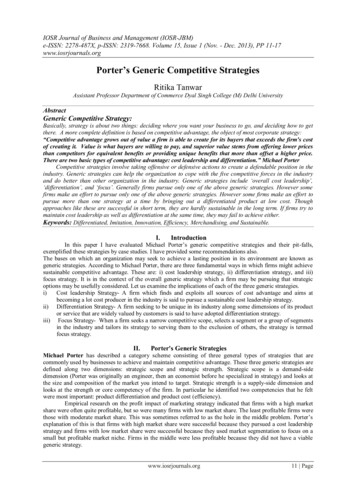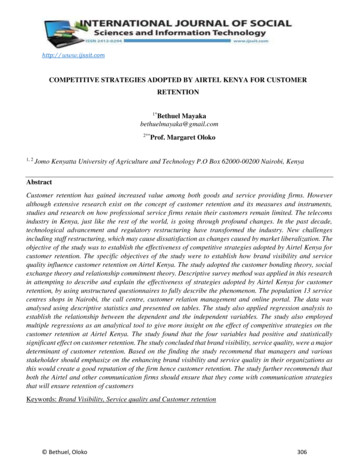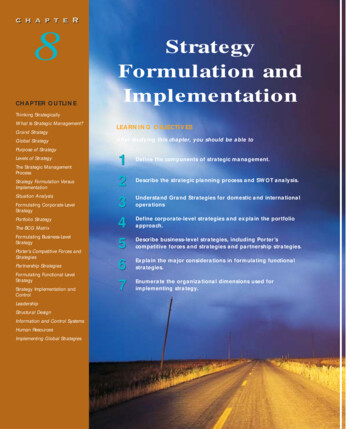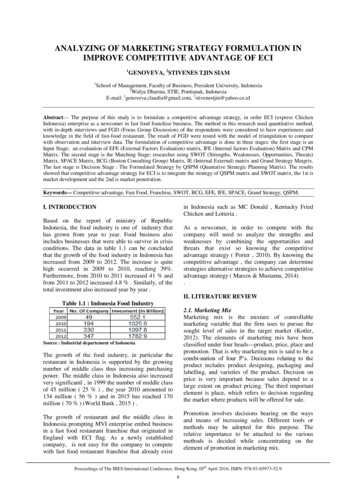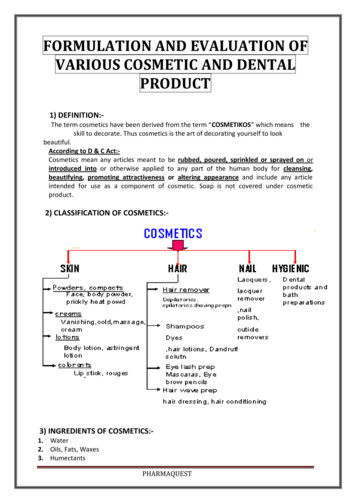
Transcription
FORMULATION OFCOMPETITIVE STRATEGIESAfter having completed the strategic analysis of a company, managersare now in the possession of a strong pool of information regarding theindustry competition, external opportunities and threats, and internalstrengths and weaknesses. Based on the information gathered, theywould logically proceed towards setting long-term objectives for theorganization. Then, they would formulate appropriate strategies in anendeavor to gain competitive advantage in the marketFormulation of strategy is a difficult task. However, in order to ease theformulation of strategy, managers need to have an in-depth look atseveral issues. They are expected to identify the generic and othercompetitive strategies as applicable to single-business company, andmatch the strategies to industry and company situations.This unit examines the competitive strategies that an organization canemploy for achieving competitive advantage. The strategies that anorganization may follow can be divided into two groups for convenienceof analysis: (1) Generic Strategies and (2) Non-Generic Strategies.Before we go for discussing about these strategies, let us first have anidea about the concept and nature of ‘competitive strategy,’ competitiveadvantage and distinctive competency in Lesson-1 of this unit.5
School of BusinessBlank PageUnit-5Page-80
Bangladesh Open UniversityLesson-1: Competitive Strategy, CompetitiveAdvantage and Distinctive CompetencyLearning Objectives:After studying this lesson, you should be able to: Explain the nature of competitive strategy. Define competitive advantage. Relate competitive advantage with competitive strategy. Discuss how an organization can sustain its competitive advantages. Clarify the concept of distinctive competency. Distinguish between competitive strategy and business strategy.IntroductionBefore we go for analyzing the issues of strategy formulation, we shouldunderstand a few concepts that are necessary to comprehend the spirit offormulating strategy in organizations. These concepts would form basisfor the formulation of strategy. The concepts that we would discuss inthis lesson are competitive strategy, competitive advantage, anddistinctive competence.Competitive StrategyCompetitive strategy consists of the business approaches and initiativesundertaken by a company to attract customers and to deliver superiorvalue to them through fulfilling their expectations as well as tostrengthen its market position. This definition of Thompson andStrickland emphasizes on ‘approaches and initiatives’ of managers indefining strategy. This means that competitive strategy is concerned withactions that managers undertake to improve market position of thecompany through satisfying the customers. Improving market positionimplies undertaking actions against competitors in the industry. Thus, theconcept of competitive strategy (as opposed to cooperative strategy) hasa competitor-orientation. Competitive strategy includes those approachesthat prescribe various ways to build sustainable competitive advantage.Management’s action plan is the focus of competitive strategy.management adopts action-plan to compete successfully with thecompetitors in the market. It also aims at providing superior value tocustomers. The objective of competitive strategy is to win the customers’heart through satisfying their needs and finally to attain competitiveadvantage as well as out compete the competitors (or rival companies.).Competitive Advantage:The Ultimate Goal of Competitive StrategyCompetitive advantage is the special edge over the competitors. Aquestion is often asked by managers: “What is the duration ofcompetitive advantage?” How long it will be sustained primarily dependson (i) barriers to imitation, (Iii) capability of competitors and (iii) thegeneral dynamism of an industry’s environment.1 ‘Barriers to imitation’create obstacles for the competitors to copy a company’s distinctiveStrategic ManagementPage-81Competitiveadvantage is thespecial edge over thecompetitors.
School of Businesscompetencies easily. Competitors will always try to imitate a company’sresources and capabilities. Evidence indicates that capabilities are moredifficult to imitate than resources. Of the resources, tangible resources(e.g., plant and machinery equipment, buildings) are easier to imitatethan intangible resources (e.g., patents, goodwill, brand names,technological know-how, marketing techniques). There is, thus, a need tobuild up distinctive competence based on unique capabilities rather thanon tangible resources. This would help the company enjoy the distinctivecompetence for a longer period of time.The capability ofcompetitors to imitatea company’s distinctive competency needto be given dueconsideration.The capability of competitors to imitate a company’s distinctivecompetency need to be given due consideration. If the competitors arestrongly committed to doing business in a particular way, they will notsuddenly imitate a company’s innovation. In such a situation, itsdistinctive competency will be sustainable for longer. The third factor ofsustainability of distinctive competency – that is, industry dynamism – isalso an important determinant of competitive advantages. Frequentproduct innovation makes an industry environment dynamic. Forexample, software industry, electronics industry and PC industry arehighly dynamic because of high rate of innovation. In such industries,competitive advantages are short-lived.How to sustain competitive advantage?Since achieving and maintaining competitive advantage is the primaryaim of competitive strategies, managers should undertake measures tosustain competitive advantage once they are achieved. Managers canbuild sustainable competitive advantage by adopting followingmeasures.2Managers can buildsustainable competitive advantage byadopting sixmeasures. Focusing on building blocks of competitive advantagesDeveloping distinctive competenciesCreating an environment of organizational learningInstituting continuous improvement mechanismInstituting best practicesOvercoming barriers to changeA brief discussion of these issues follows:1. Focusing on building blocks of competitive advantages: As statedearlier, a company has a sustained competitive advantage when it canmaintain higher-than-industry-average profit rate over a number ofyears. This becomes possible when the company emphasizes on thefour generic building blocks of competitive advantage, such as (a)efficiency, (b) quality, (c) innovation, and (d) customerresponsiveness. Because of its focus on these building blocks, AppleComputer Company enjoyed sustained competitive advantage over along period from 1987 to 1993.3 These are called ‘generic’ becauseany organization can adopt them irrespective of its products (orindustry in which it operates its business). Superior efficiencyenables a company to lower its costs; superior quality allows it bothUnit-5Page-82
Bangladesh Open Universityto lower costs and charge a higher price; superior customerresponsiveness allows it to charge a higher price; and superiorinnovation can lead to higher prices or lower unit costs. Togetherthese four building blocks help a company create more value than thecompetitors. Thus, company can enjoy a sustained competitiveadvantage.2. Developing distinctive competencies: Managers have to developdistinctive competencies in order to sustain competitive advantage.When distinctive competencies are developed, they help inimproving performance in all the areas of four building blocks.Distinctive competencies should be developed in all required areas –never in some areas at the cost of other important areas. Companiesneed to be balanced in their pursuit of distinctive competencies.3. Creating an environment of organizational learning: Sustainingcompetitive advantage requires a congenial environment in theorganization that promotes learning within the organization(commonly known as organization learning). Learning organizationscan keep themselves at the top of all competitors because they arealways in search of knowledge. In the process of seeking anddisseminating knowledge, they learn from prior mistakes andimprove their work-processes over time.4. Instituting continuous improvement mechanism: Continuousimprovement of the quality of both products and services (in fact, ofeverything that a company does) in sine quo non for sustainingcompetitive advantage over a longer period of time. Managers needto devise dynamic ways to improve quality on a continuous basis.Some organizations have been successful in their endeavor toimprove quality through instituting total quality management (TQM)program and business process reengineering.5. Instituting best practices: Adoption of ‘industrial best practices’helps in developing distinctive competencies and thereby insustaining competitive advantage. Organizations can benchmark(search out) the successful business-practices of othercompetitors/companies in other industries and then adopt them afternecessary fine-tuning. Thus, they can build and maintain resourcesand capabilities – that are essential to achieve excellence inefficiency, quality, innovation and customer responsiveness.6. Overcoming barriers to change: Companies fail to sustaincompetitive advantage as because they are unable to adapt tochanges in the organization. They need to overcome the resistancesto change so that they can maintain competitive advantage.Companies can overcome the barriers to change through providingeffective leadership, necessary changes in organization structure,creating appropriate control systems and involving employees indecision making.Strategic ManagementPage-83
School of BusinessDistinctive Competency:An Essential Requirement for Achieving Competitive AdvantageDistinctivecompetencies refer tothose strengths of theorganization thatallow it to attaincompetitive advantage in the market.A business organization must have distinctive competency in one ormore areas of its activities in order to be competitive in the marketplace.Distinctive competencies refer to those strengths of the organization thatallow it to attain competitive advantage in the market. These strengthsare unique for the organization and they help it achieve superiorefficiency, quality, innovation and customer responsiveness. It can beargued that Partex has distinctive competencies in the case ofmanufacturing bottled drinking water – MUM. Distinctive competencieshave helped Partex achieve lower costs and make product differentiationbetter than its competitors. Thus, distinctive competencies have beenhelpful in attaining distinctive advantages through achievement ofsuperior efficiency and quality.Unique organizational resources and capabilities constitute anorganization’s distinctive competencies. However, the resources of theorganization must be unique (i.e., no other companies have theseresources) to be regarded as distinctive competencies. The resourcescomprise physical, human, financial, informational, and technologicalresources. An organization’s capabilities are the skills necessary toexploit the resources for productive use. Capabilities are intangible. Itmay be noted that an organization may not need unique resources toestablish a distinctive competence as long as no other competitorspossess such resources. An organization can create distinctivecompetencies only when it simultaneously has unique resources and hasthe capabilities to use those resources effectively. Successful strategiesoften either build on a company’s existing competitive competencies orhelp a company develop new ones.Competitive Strategy Versus Business StrategyBusiness strategyconsists of plans ofaction that strategicmanagers adopt touse a company’sresources anddistinctivecompetencies to gaina competitiveadvantage over itsrivals in a market.Business strategy has a wider scope than competitive strategy. Businessstrategy encompasses all the actions and approaches for competingagainst the competitors and the ways management addresses variousstrategic issues. As Hill and Jones have remarked, business strategyconsists of plans of action that strategic managers adopt to use acompany’s resources and distinctive competencies to gain a competitiveadvantage over its rivals in a market. In doing business, companiesconfront a lot of strategic issues. Management has to address all theseissues effectively to survive in the marketplace. Business strategy dealswith these issues, in addition to ‘how to compete.’ The competitivestrategy, on the other hand, deals with “management’s action plan forcompeting successfully and providing superior value to customers.”Unit-5Page-84
Bangladesh Open UniversityReview Questions1. What is meant by competitive strategy? What are the actions is itconcerned with?2. What is competitive advantage? Why is it considered as the ultimategoal of competitive strategy?3. As a manager of an organization, what measures would youundertake to ensure sustenance of competitive advantage?4. “Distinctive competencies have been helpful in attaining distinctiveadvantages through achievement of superior efficiency and quality.”Explain the statement.5. Explain what you mean by distinctive competency. How doesdistinctive competency help in achieving competitive advantages?6. What are the differences between competitive strategy and businessstrategy?Application Discussion Questions1. What competitive advantage does your university possess? Why doyou think that it is a competitive advantage? Ask your friends toverify whether they also agree with your opinion.2. Visit a neighborhood grocery store and ask the owner or manager ifthe store has any distinctive competency. Using the definition ofdistinctive competency presented in this lesson, ask themanager/owner if the definition is consistent with how he/she thinksof distinctive competency.Strategic ManagementPage-85
School of BusinessLesson-2: Generic Competi
They are expected to identify the generic and other competitive strategies as applicable to single-business company, and match the strategies to industry and company situations. This unit examines the competitive strategies that an organization can employ for achieving competitive advantage. The strategies that an organization may follow can be divided into two groups for convenience of .
